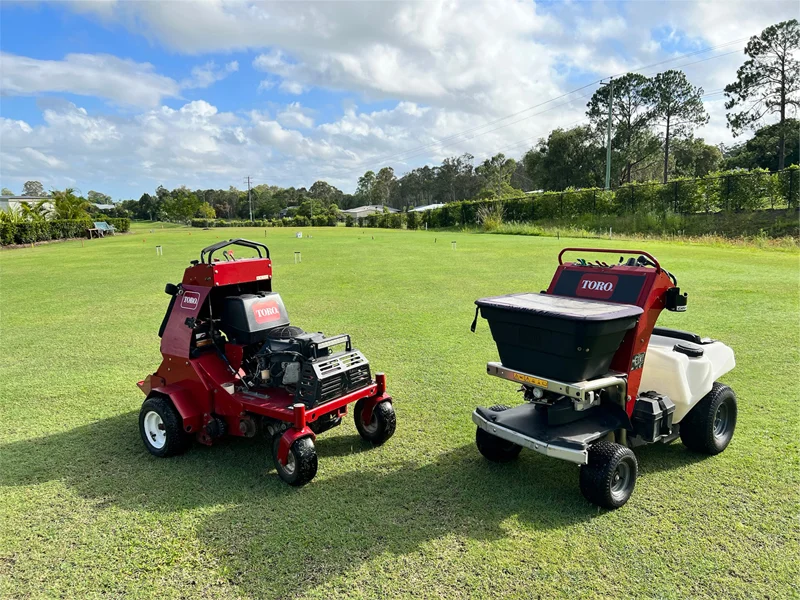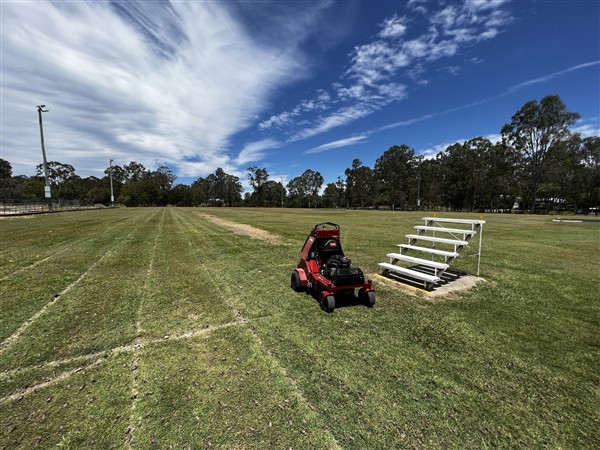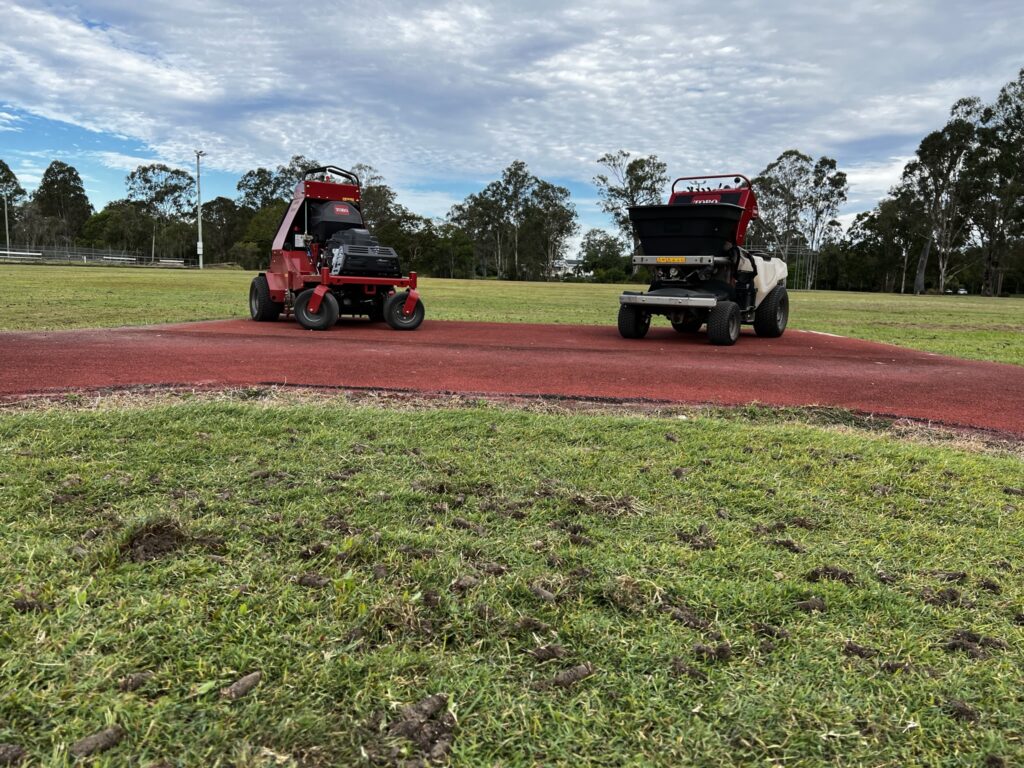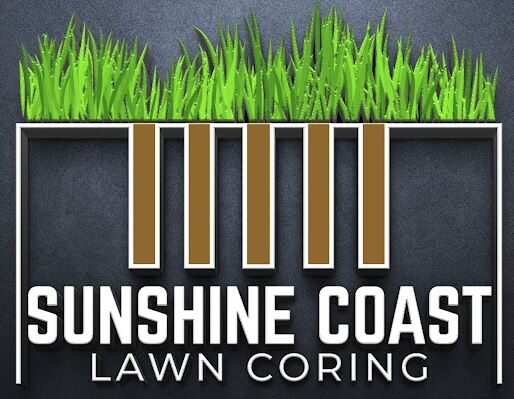Just like us, lawns also breathe. They need proper aeration to assure they get the nutrients, air, and water necessary for healthy growth and vibrancy. But when is the right time to aerate your lawn? The significance of selecting the appropriate time for aeration cannot be overstated.
Choosing the right time to aerate your lawn maximises the benefits of this crucial lawn care practice. Timing plays a vital role in helping your lawn become more resistant to pests and diseases, ensuring better n
utrient uptake, and promoting lush, healthy growth.
But don’t worry about figuring it all out by yourself. We at Sunshine Coast Lawn Coring have dedicated our expertise in helping you make the best decisions for your lawn, including choosing the most appropriate time for lawn core aeration.

The Climate of Sunshine Coast
The Sunshine Coast, known for its stunning beaches and vibrant coastal towns, is blessed with a sub-tropical climate. It is characterised by warm, wet summers and mild, dry winters, with an average annual temperature of approximately 25 degrees Celsius, making it an appealing place to live all year round.
Influence of Climate on Lawn Care Practices
The sunshine, warmth, and abundant rainfall prove beneficial for a variety of lush, green turfs to thrive. But the same conditions can also lead to soil compaction and thatch build-up – a layer of organic debris that blocks the absorption of nutrients, water, and air to the grassroots.
Appropriate lawn care practices become essential in such a climate. Routine activities like mowing, fertilising, and importantly, aeration, help keep your lawn rejuvenated and healthy. Aeration is a critical process that facilitates the penetration of nutrients, air, and water into the soil and roots, ultimately leading to a robust and verdant lawn.
Seasons on the Sunshine Coast
The Sunshine Coast experiences two distinct seasons:
- The Wet Season (Summer): Occurring from December to March, the wet season is marked by high temperatures, increased rainfall, and high humidity. This is typically the period when grass growth is at its peak.
- The Dry Season (Winter): This season begins in June and ends in August. The weather turns cooler with decreasing levels of rainfall. While the growth of grass slows down, it provides an excellent opportunity for lawn maintenance activities, including aeration and fertilisation
Knowing which season you’re in goes a long way in making informed decisions about lawn care actions, ensuring you always have a stunning outdoor surface.
Understanding Core Aeration

Core aeration is a lawn maintenance process that involves mechanically removing small cores, or plugs, of soil and thatch from your lawn. The holes created by pulling out these plugs allow water, air, and nutrients to permeate the soil more easily, reaching the grass’s root system.
There are several benefits of core aeration:
- Improved Air Exchange: The punctured holes offer an open pathway for oxygen exchange between the root system and the atmosphere, facilitating better grass growth.
- Enhanced Soil Structure: Core aeration alleviates soil compaction, leading to better roots growth because of increased availability of essential nutrients, air, and water.
- Reduced Thatch Accumulation: As the process removes a layer of thatch, it aids in the decomposition of this organic matter, returning valuable nutrients to the soil.
- Improved Water Intake: Aeration enables water to seep deeper into the soil, reducing water run-off and promoting deeper root growth.
- Better Adaptation to Stress: A well-aerated lawn is better equipped to handle environmental challenges like drought, heat, or disease, ensuring a healthier lawn in the long run.
How Aeration Works in Improving Lawn Health
Aeration is essential in maintaining turf vigour and playability. By creating small perforations in the lawn’s surface, core aeration allows grassroots to expand and develop more robustly. The increased uptake of nutrients, air, and water, as well as reduced thatch build-up, leads to stronger and healthier grass.
Furthermore, aeration supports the biological breakdown of thatch by introducing microorganisms that help break down organic matter. This natural decomposition process gradually releases vital nutrients back into the soil, boosting lawn health and providing a more sustainable, beautiful landscape.
Core aeration is a crucial part of lawn care, as it significantly improves lawn health by optimising the absorption of essential elements, reducing compaction and thatch, and ultimately creating a visually appealing, resilient lawn for homeowners up and down the Sunshine Coast.

Ideal Time for Core Aeration on the Sunshine Coast
Choosing the perfect time for core aeration can make all the difference in the health and appearance of your lawn. On the Sunshine Coast, the mild climate and unique environmental conditions offer a variety of opportunities for aeration.
Spring Aeration
As the Sunshine Coast witnesses a gentle transition from winter to spring, it presents an ideal time to breathe new life into your lawn through core aeration. Let us explore the benefits that spring aeration brings to the table and the specific considerations in terms of temperature, weather, and grass growth on the Sunshine Coast.
Advantages of Spring Aeration
- Revitalising Winter-Weary Lawns: A spring aeration can revive lawns faced with thatch accumulation and soil compaction after the winter, restoring their vigor and enhancing their health.
- Preparing for the Growing Season: Spring aeration on the Sunshine Coast sets the stage for a lush and healthy lawn during the upcoming growing season by optimising nutrient, water, and air uptake.
- Encouraging Strong and Deep Root Systems: Aeration in the spring can promote stronger, deeper roots, better equipping your lawn to endure the local weather conditions and making it more resilient to pests and diseases.
Temperature and Weather Considerations
The mild and wet climate on the Sunshine Coast generally results in moderately moist soil and temperate weather, providing an excellent foundation for spring aeration. Nonetheless, it is vital to ensure that the soil is not too wet from excessive rainfall, as this can lead to soil compaction rather than relief. Timely aeration in favourable weather ensures that your grass gets the full benefits of this process.
Grass Growth and Recovery during Spring
One of the notable features of the Sunshine Coast’s climate is the extended growing season, which makes spring aeration a valuable investment. By aerating during spring, you can establish a solid foundation for a period of flourishing growth and recovery for your lawn. The vibrant grass growth on the Sunshine Coast ensures rapid recovery after aeration, effectively filling the punched holes and quickly displaying the visual improvements from the process.
Autumn Aeration
Autumn presents an ideal time for lawn aeration, a process that can significantly enhance your yard’s health and appearance. But why is this season particularly beneficial for this lawn-care activity?
Benefits of Autumn Aeration
- Intensive Root Growth: Autumn aeration promotes deep rooting, allowing the roots to receive more water, air, and nutrients before the onset of winter.
- Thatch Control: By controlling thatch build-up and soil compaction, Autumn aeration reinforces the health of your lawn throughout the year.
- Increased Nutrient Uptake: Autumn aeration enhances the effectiveness of fertilisers by allowing nutrients to penetrate deeper into the soil, essential for the health of the lawn during winter dormancy.
Cooling Temperatures and Rainfall Patterns
Autumn marks a transition from the extreme temperatures of summer to cooler, more moderate conditions. This period often experiences more rainfall than summer, resulting in moist and softer soil—a perfect condition for core aeration. The presence of moisture makes it easier for the aerator to pull out the plugs, and the lower temperatures reduce the chances of lawn stress due to heat, ensuring the lawn can recover more efficiently post-aeration.
Preparing the Lawn for Winter Dormancy
Autumn aeration plays an essential role in getting your lawn ready for winter dormancy. The process strengthens the lawn’s root system and ensures an influx of vital nutrients before the ground freezes. A healthy, fortified root system assists your lawn in withstanding the harsh temperatures and allows the turfgrass to bounce back to life more effectively in the subsequent growing season.
Avoiding Summer and Winter Aeration
While both spring and autumn aeration can be beneficial for the overall health and vibrancy of your lawn, undertaking this task during the extremes of summer and winter can pose unique challenges that may outweigh the potential benefits. In this section, we look at the potential risks of aeration during these harsher seasons, dissect the vulnerabilities of lawns during these times, and provide reasons to steer clear of summer and winter aeration.
Challenges and Risks Associated With Summer Aeration
- Heat and Drought Stress: High temperatures in the summer can cause significant stress to your lawn. Aeration during this time might further stress the grass and potentially risk burning it out.
- Increased Water Consumption: Aeration in high heat may also increase the lawn’s water consumption, which can be problematic during periods of water restrictions or drought.
- Limited Recovery Time: Grass growth tends to slow down in the hot summer months, which can hinder its recovery process after aeration.
- Increased Water Demands: Post-aeration, a lawn may require more water, which can be challenging given the summer’s higher evaporation rates.
- Pest and Weed Intrusion: Summer aeration can open up your lawn to invasive weeds and lawn pests who are generally more active during the hotter months, thereby potentially diminishing the health and aesthetics of your lawn.
Vulnerabilities of Lawns in Winter
On the other hand, winter is generally a dormant period for most lawns. In many cases, grass growth slows significantly and can scarcely handle the stress of aeration during this time.
- Slower Recovery: Aeration prompts the growth and spread of grass to fill in the holes. However, during winter, lawns will recover at a much slower pace due to the halted growth rate, often leading to longer periods of unsightly plug-filled lawns.’
- Frozen Ground: During winter, the ground can freeze, making it difficult or even impossible to penetrate the soil with an aerator.
- Dormancy Phase: Grass enters dormancy during winter, stalling growth and recovery. As a result, the lawn will not recuperate from aeration as effectively as it would during the active growth season.
- Increased Soil Compaction Risk: Winter precipitation and snow could cause soil to become compact, potentially exacerbating existing compaction issues and making aeration less effective.
- Risk of Winter Damage: If a lawn is aerated in the late winter, the cold weather and potential frost can harm the exposed roots and the grass’s overall health. It can also increase the risk of winter diseases and pests.
Given the challenges and vulnerabilities discussed above, it is typically best to avoid core aeration in the extreme summer and winter seasons. Instead, focusing on the more temperate and balanced seasons of spring and autumn will help to ensure a more successful and effective aeration process, ultimately leading to a healthier and more visually appealing lawn.
Assessing Your Lawn's Needs
Understanding when your lawn requires aeration can make all the difference in its health, growth, and overall aesthetics. It’s crucial to be aware of the signs that indicate that your lawn might be ready for some timely intervention. In this section, we break down the key indicators that signal the need for aeration, including signs of compacted soil, thatch accumulation, and slow-growing grass.
Signs That Your Lawn Requires Aeration
Compacted Soil Indicators
Compacted soil can impede the healthy growth of grass by limiting the penetration of water, air, and nutrients. Some signs pointing to soil compaction are:
- Hard, dry patches that are difficult to penetrate with a shovel or rake
- Standing water or puddles after rain, indicating that water is not soaking into the soil effectively
- Areas of soil that are consistently walked or driven on, leading to compaction over time
Thatch Accumulation
Thatch is a layer of dead grass, roots, and other organic debris that forms between the grass and the soil surface. Moderate thatch can be beneficial, but excessive accumulation can prevent water, air, and nutrients from penetrating the soil. The following are indicators that your lawn may have a thatch problem:
- A spongy or springy feeling when walking on the grass
- Visible layer of dead grass and debris on the surface of the lawn
- Difficulty in pushing a screwdriver or similar object through the thatch layer
Sluggish Grass Growth
Slow or uneven grass growth is often a result of the lawn struggling to access the required nutrients, water, and air for vigorous growth. Signs of poor grass growth that signal the need for aeration include:
- Thin or patchy grass that does not respond well to watering and fertilising
- Yellowing or browning of lawns despite regular maintenance
- Weakening grass that becomes more susceptible to pests, weeds, and diseases
By keeping an eye out for these symptoms, you can recognize when your lawn is ready for aeration and ensure its health and vibrancy throughout the changing seasons.
Conducting a Soil Test for Better Timing Decisions
A soil test provides an informative snapshot of the current condition of your lawn’s soil, highlighting the nutrient levels, pH balance, and organic matter content. By understanding your soil’s condition, you can make more informed decisions on when and how to correctly aerate your lawn.
Here’s a simple guide to conduct this test and interpret the results.
Step 1: Gather Samples
Using a clean trowel or soil probe, gather samples from several different spots around your lawn. Aim to collect from the top 6 to 8 inches of the soil, as this is the root zone where most nutrient activity takes place. Remember to avoid sampling from areas near driveways or roadsides where the soil may be contaminated.
Step 2: Combine and Dry the Sample
Combine all the soil samples in a bucket and give it a good mix. This will ensure that your sample is representative of the average condition of your lawn. Next, lay it out to dry naturally. Avoid using heat to speed up the process as it could alter the soil properties.
Step 3: Send the Sample for Testing
Once the soil is dry, package it following any instructions given by your chosen soil testing lab and send it off for analysis. Many Cooperative Extension Service offices in various states offer soil testing services for free or at a nominal cost.
Step 4: Understand the Results
The lab will test for several crucial aspects of soil health, including pH level, nutrient content (nitrogen, phosphorus, and potassium), and organic matter percentage.
- pH Level: The pH level indicates the acidity or alkalinity of your soil. Most grasses prefer a slightly acidic soil with a pH of 6 to 7. If the test shows your soil’s pH is out of this range, you might need to add lime to raise pH (if your soil is too acidic) or sulphur to lower pH (if your soil is too alkaline) before aeration.
- Nutrient Content: High levels of nutrients (especially phosphorus and potassium) can lead to thatch buildup, indicating the need for aeration. Similarly, if nutrient levels are too low, aeration can help improve nutrient uptake.
- Organic Matter: If the percent of organic matter in the soil is high, your lawn may have a thatch problem, signalling an urgent need for aeration.
By examining your soil test results, and taking into account other important signals from your lawn (like compaction and slow growth), you can decide whether your lawn needs aeration and when would be the optimal time to perform it.
Consulting Local Lawn Care Experts
While individual assessments and soil tests can provide valuable insights into the health of your lawn, consulting local lawn care experts can elevate your understanding of your lawn’s specific needs and guide you towards the most effective aeration schedule. Here’s how you can leverage professional expertise for the betterment of your lawn.
1. Access to Expert Knowledge
Local professionals have deep-rooted knowledge and understanding of regional climate, soil types, and native grass species. Drawing upon their expertise can help in diagnosing any lawn issues more accurately and in deciding the most beneficial timing and frequency for aeration. They can also provide insights into complementary lawn maintenance tasks, like post-aeration care and fertilisation.
2. Custom Lawn Care Plan
Lawn care experts can develop customised care plans tailored to your specific lawn’s condition and your aspirations for it. For example, lawns experiencing heavy foot traffic may need more frequent aeration, while those under shade might need fewer sessions. Professionals can fine-tune these details to optimise the effectiveness of the care plan.
3. Hassle-Free Aeration
Aeration can be labour-intensive and requires special equipment. Professional lawn care services come equipped with the necessary tools and knowledge to do the job efficiently and effectively, saving you time and effort. Moreover, they have access to commercial-grade, core aerators that can perform a more effective aeration than most consumer-grade models.
4. Ongoing Support
Lastly, professional lawn care doesn’t end with a single aeration session. These experts offer ongoing support to ensure your lawn stays healthy and vibrant throughout the seasons. This support includes regular monitoring, timely maintenance, and adjustments to the care plan if necessary. They can also provide insightful tips and address any concerns or queries that you might have regarding lawn care.
Engaging local lawn care professionals isn’t merely about outsourcing a task; it’s about establishing a partnership that supports and nurtures your lawn’s growth and health over the long term. Their expertise, honed by years of experience, can provide invaluable guidance on effective lawn management, including the ideal timing for core aeration.
Bring Your Lawn to Life with Sunshine Coast Lawn Coring
Don’t let the beauty of your outdoor space lose its lustre due to compacted soil and poor nutrient absorption. It’s time to reclaim your lovely lawn with Sunshine Coast Lawn Coring.
Give your lawn the refreshing breath it yearns for; give your lawn the Sunshine Coast Lawn Coring touch. Let’s start the journey to attain richer, healthier, and more vibrant lawns. Choose Sunshine Coast Lawn Coring.
Contact us today to turn your dream lawn into a lush reality!
